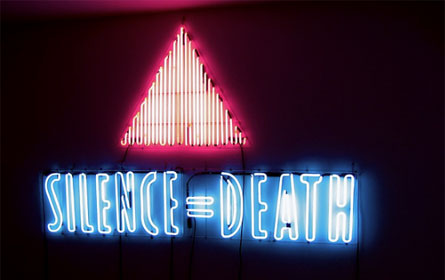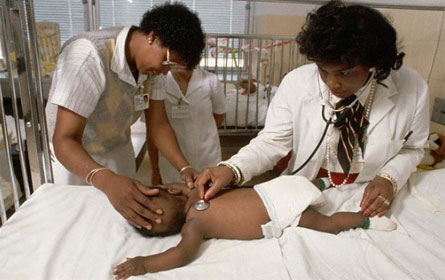
Part one of two. For part two, go here.
In 1984, when Jim lost his 22-year old boyfriend to AIDS, he didn't think he would live to see 30. When he was diagnosed with HIV himself five years later, Jim never expected to turn 40. He had stopped counting how many friends had died when that number reached 200.
The medication available at the time, AZT, was supposed to be taken three times daily, but Jim could not handle even a portion of that dose without getting sick. So he put off treatment until 1997. By then Jim's T cell count was below 200, the demarcation for HIV turning into AIDS. Fortunately, antiretroviral medications -- much more powerful drugs with fewer side effects -- were just being approved, and Jim's reaction to them was quite good. His T cell count soon rose to 350.
Today, 21 years after being diagnosed with HIV, Jim, at 57, is still with us, and his outlook for the future is much improved.
Jim is not alone. Like Jim, Keith (not his real name), who was diagnosed with HIV in 1994 at age 29, also never thought he’d still be here.
"There's a lot of us," Keith said. "I think something else will kill me before HIV. I know people who are still alive who have had the illness now for 20 to 25 years and longer, from the 1980s. … It's not on my radar to die from HIV any longer."
More than 30 years after the first known death from AIDS in New York City – and on the eve of World AIDS Day – much has changed since the epidemic ripped through the city in the 1980s. Major advances have been made in treating HIV and AIDS, and social service agencies have stepped in to meet the needs of many HIV positive people who need help.
Yet challenges remain. Every year some 1,000 New Yorkers still are diagnosed with HIV so late it has already become AIDS. Many others go untested –- and undetected. And the city must now deal with a population many thought it would never have to serve: aging people with HIV/AIDS.
By 2015, over half of people in the United States living with HIV will be over the age of 50. In New York City, almost 40 percent of the estimated 107,000 New Yorkers living with an HIV/AIDS diagnosis are over age 50, and 75 percent over 40.
Their longevity is testimony to the success of what has been done to combat HIV/AIDS. Living with HIV into middle age and beyond, though, presents another set of issues: medical, financial, social and personal.
Knowing Helps
Youth, particularly young men having sex with men, are still seriously at risk for new infections. Even though, overall, new HIV diagnoses in the city have decreased, they continue to rise among the young, particularly young gay and bisexual men. And African American men, ages 13 to 29, experienced the greatest increase in new infections in 2009: 48 percent.
Knowing your HIV status and, if you are HIV-positive, getting access to the life-saving drugs are prerequisites for survival. With that in mind, the city and state have taken steps to tell people about the tests and increase their availability.
"Once people become aware of their HIV-positive status," Rod McCullom wrote for the Black Aids Institute, "not only are they more likely to take steps such as using condoms to avoid infecting their sexual partners, but research now shows that beginning treatment soon after diagnosis makes people with HIV/AIDS significantly less infectious."
Last year, New York state passed a law requiring that HIV testing be offered to people aged 13 to 64 in primary care, hospitals or emergency rooms. Patients can refuse the test. The city now mandates sex education classes in public schools for middle and high school students that will include curriculum about unprotected sex and how to use condoms.
And the city health department has come out with a graphic public service announcement, “It's Never Just HIV," illustrating the other medical problems that often accompany HIV in an attempt to curb complacency and urge viewers to use condoms.
Reducing Risks
Over the years, targeted programs have helped drive down new infections among at risk groups.
Intravenous drug use -- once a major means of transmission of HIV in the city -- has been reduced to 4.4 percent of new HIV diagnoses owing largely to syringe exchange programs that allow adults to purchase up to 10 needles without a prescription from a pharmacy or to obtain them from registered health care facilities. The state also recently changed its penal law so that possession of a residual amount of a controlled substance in or on a syringe is no longer a crime, although there are still reports of police harassment around needle exchange programs. Advocates would like to see more efforts to train police on the benefits of needle exchange.

Mother-to-baby transmission has been virtually eliminated in New York state by mandatory testing of all babies born, if the pregnant mother has declined a test, followed by immediate treatment — which can expel the virus in two-thirds of the infants — when HIV is present.
But while the youngest New Yorkers get tested, older ones frequently do not. This is true even though people over 50 account for 17 percent of the new diagnoses of HIV in New York.
African Americans over 50 are 12 times as likely as their white peers to contract HIV, and Latinos are five times as likely, according to a Centers for Disease Control publication. African American women over the age of 50 make up 65 percent of all women with HIV and 67 percent of new diagnoses among women in New York City. Three quarters of these woman report unprotected heterosexual sex as the means of transmission.
In December 2009, the federal government announced that Medicare will now cover HIV screening tests for people over 65.
Every step forward, however, highlights the gaps left behind. For example, the Centers for Disease Control issued a recommendation that all people aged 13 to 64 year get annual HIV tests . “Great!” said Nathan Schaefer, director of public policy at the Gay Men's Health Crisis. But, he added, the government should recommend HIV tests for all ages, particularly in light of Medicare's decision to make HIV testing available to those over 65.
The lack of tests speaks partly to the common assumption that seniors do not have sex, even though a 1998 study by the National Council on Aging found that 61 percent of men and 37 percent of women over 60 were still sexually active. Those numbers probably have increased with the erectile–dysfunction pills now available.
Adults over 50 at risk for HIV were 80 percent less likely to be tested as at-risk adults 20 to 30 years of age, according to one study.
Doctors may not ask their older patients if they are sexually active. Men over 50 who are having sex with other men, afraid of anti-gay bias, may not disclose this to their doctor. Women who have entered menopause, no longer concerned about pregnancy, often will not use protection and will seldom discuss this with a health-care provider.
Older people's symptoms of HIV/AIDS were also frequently misdiagnosed as other illnesses. "Sometimes the effects of HIV among older adults, such as fatigue and cognition loss, are perceived to be just part of aging process," said Schaefer.
Because many older adults are not tested they may only discover they have HIV while being treated for other conditions. Frequently, this is long after they contracted the illness, so it has progressed to AIDS and likely been transmitted to others.
"The CDC really needs to develop a preventive program targeted for older adults," said Schaefer. "Current CDC models for prevention for high risk populations do not include seniors. These models … have been demonstrated to be efficacious and are used to shape new prevention programs. But not one has been designed for older adults."
After the Test
Testing enables people to get help sooner, increasing their chances of survival. But many need government assistance as well.
Ethan (not his real name) was diagnosed with HIV in 2005, at age 56. He is 62 now. "At first my T cell count was very high. I was still healthy from a statistical point of view. So I was able to distance myself. Yeah, I got it, but I don’t need medication. And that was a source of pride," he said.
He delayed going on the drugs, but, he continued, "Every time I had blood work done, my T cell count was going down. … I was very weak. I realized it finally became time to go on the medications."
When Ethan handed the prescription to the pharmacist, he was told that his insurance company was not going to pay for it. “The pharmacist told me I had $1,000 annual limit on medication. Just one of the medications the doctor was prescribing, to keep me from getting pneumonia, would cost $3,000 a month.
Fortunately, Ethan's doctor figured out that Ethan would qualify for AIDS Drug Assistance Programs or ADAP. As a result, Ethan said, "I finally got on the medications and I got stronger."
ADAP is one of the many programs established in the last 30 years to assist people with HIV/AIDS. New York, more than many other states, does try to provide some kind of a safety net to people with the virus.
"We're fortunate to live in a state that is so dedicated to good health care," said GMHC's Schaefer. With states across the country cutting their budgets, Schaefer said, "a lot of states are experiencing more need than they are able to meet" and have waiting lists for medications. These states, according to Schaefer, "are not able to put up the money to make the required dollar match to pull down the maximum amount of federal reserves. But New York does."
The help extends beyond medication. Once Keith began treatment, he never had a problem getting services and help in the city. After he was laid off from his job, he applied for public assistance through the HIV/AIDS Services Administration, or HASA, an organization that helps folks diagnosed with AIDS or symptomatic HIV find emergency housing, financial assistance, medical care and other services.
"New York state is really great," said Keith. "I thought for years about moving away, for various reasons, but because of the care here -- my doctor, the medications, the services -- I won't." He said he also has gotten " wonderful support" from three nonprofits: GMHC, Friends in Deed, a support organization for people affected by life-threatening illness; and the New York Buyers Club for nutritional supplements.
Still in Need
But not everyone in New York has thrived. HIV related illness is the number one cause of death for women in New York City’s shelter system, according to a 2005 reportfrom the city health department and the Department of Homeless Services.
"Affordable and stable housing is a serious priority for people living with HIV," said Schaefer. "Studies show that if someone is permanently housed, the outcome is better in every way. "
With housing costs so high in New York, finding that stable situation can pose a challenge.
The neighborhood you live in also may put you at risk. People living in neighborhoods with high rates of poverty, substance abuse and sexually transmitted disease. as well as a prevalence of HIV and low rates of testing, are at high risk for HIV infection. These neighborhoods include Central Brooklyn, Harlem, the South Bronx, Hell’s Kitchen, the West Village and Chelsea. All except Chelsea also have high death rates associated with AIDS. Lower income communities face higher death rates than other areas with similar HIV prevalence.
Part one of two. For part two on aging with HIV and budget challenges, go here.




